

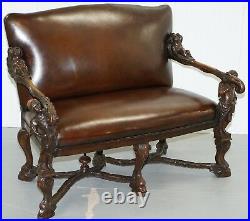
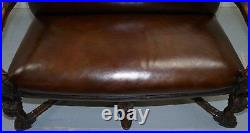


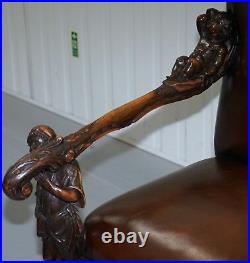
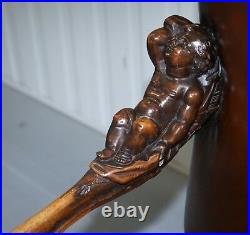
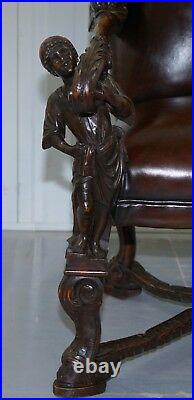
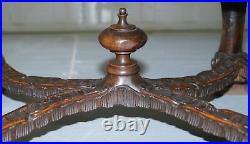
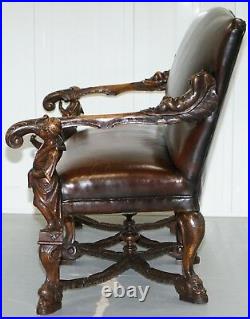
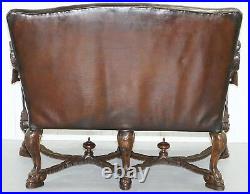
This piece is in simply amazing condition throughout, its a very early model. This impressive carved walnut throne settee has a raked padded back above a stuffed over seat. The arms are carved to the elbow with recumbent putti figures looking skyward, carved almost in the round and supported by foliate sprays. The exuberantly carved neoclassical figures supporting the carved foliage arms are simply works of art, the side stretchers carved with scrolls meeting at the centre in a cartouche. The vigorous Baroque style of carving echoes the style of Andrea Brustolon (16621732), an important sculptor and wood carver who made furniture for many of the great Venetian Palaces. In terms of condition the timber has been lightly cleaned hand condition waxed and hand polished, the leather upholstery is fine Italian heritage hide, we have had in leather polished to the deep cigar brown colour. Height:- 106.5cm. Please note all measurements are taken at the widest point, if you would like any additional or specific measurements please ask. Andrea Brustolon (20 July 1662 25 October 1732) was an Italian sculptor in wood. He is known for his furnishings in the Baroque style and devotional sculptures. He was trained in a vigorous local tradition of sculpture in his native Belluno, in the Venetian terraferma, and in the studio of the Genoese sculptor Filippo Parodi, who was carrying out commissions at Padua and at Venice (1677). He spent the years 1678-80 at Rome, where the High Baroque sculpture of Bernini and his contemporaries polished his style. Apart from that, the first phase of Brustolon’s working career was spent in Venice, 16801685. Brustolon is documented at several Venetian churches where he executed decorative carving in such profusion that he must have quickly assembled a large studio of assistants. As with his contemporary in London, Grinling Gibbons almost all the high quality robust Baroque carving in Venice has been attributed to Brustolon at one time or another. In the Venetian Ghetto, at the Scola Levantina, Brustolon provided the woodwork for the synagogue on the piano nobile, where the carved, canopied bimah is supported on Solomonic columns, which Brustolon had seen in Bernini’s baldacchino in the Basilica of St Peter’s. His furniture included armchairs with figural sculptures that take the place of front legs and armrest supports, inspired by his experience of Bernini’s Cathedra Petri. The gueridon, a tall stand for a candelabrum, offered Brustolon unhampered possibilities for variations of the idea of a caryatid or atlas: the familiar Baroque painted and ebonized blackamoor gueridons, endlessly reproduced since the eighteenth century, found their models in Brustolon’s work. His secular commissions from Pietro Venier, of the Venier di San Vio family (a suite of forty sculptural pieces that can be seen in the Sala di Brustolon of the Ca’ Rezzonico, Venice), from the Pisani of Strà, and from the Correr di San Simeone families encourage the attribution to him of some extravagantly rich undocumented moveable furniture. Andrea Brustolon’s elaborate carved furniture aspired towards the condition of sculpture, such as the Dutch bases for console tables which look like enlargements of the work of the two Van Vianens, Paulus and Adam, perhaps the greatest Dutch silversmiths of the period. These carved pieces display the baroque tendency to develop a form three-dimensionally in space. Brustolon’s walnut, boxwood and ebony pieces transcend ordinary functional limitations of furniture; they are constructed of elaborately carved figures. The framework of Brustolon’s chairs, side tables and gueridons were carved as gnarled tree branches, with further supports of putti and moors carved in ebony. Backrests of the chairs, which were never touched in the rigidly upright posture that contemporary etiquette demanded, were carved with allegories of vanity, fire and music, etc. The most extravagant piece delivered for Pietro Venier was a large side table and vase-stand of box and ebony, designed as a single ensemble to display rare imported Japanese porcelain vases. The eclectic allegories include Hercules with the Hydra and Cerberus, moors and reclining river-gods see ref. For the Correr, less extrovert chairs bear female nudes extended along the armrests. For the Pisani, he carved a suite of twelve chairs (now at the Palazzo Quirinale) with flowers, fruit, leaves and branches to symbolize the twelve months of the year. Work by Brustolon is at the Villa Pisani at Stra. His polychromed ivory Corpus from a crucifix is in the Museo Civico di Belluno, which preserves some of Brustolon’s preparatory drawings for frames to be carved with putti displaying emblems. A pair of boxwood sculptures, The Sacrifice of Abraham and Jacob Wrestling with the Angel, integral with scrolling barocchetto stands, were in the collection of Justus Liebig (Liebigshaus, Frankfort). 1720, is at the Victoria and Albert Museum, London. He died in Belluno in 1732. He studied from 1855 to 1857 in Venice and his career developed the most in there and in Belluno, although it was also turned to countries beyond the Alps. He applied in furniture and in ecclesiastical and secular decoration, showing his talents in furniture and frames making. Catalogue by Massimo de Grassi, Valentino Panciera Besarel, Verona, 2002 and was the subject of a monograph, Giovanni Angelini, Gli Scultori Panciera Besarel (Belluno 2002). Andrea Brustolon (Istituto Veneto Arti Grafiche) 1969. Il mobilio del’700 veneto. La scultura veneta del Seicento e del Settecento (Turin: Alfieri). Indice delle opere d’arte della città e provincia di Belluno (Venice). Brustolon, preface by U. This item is available for collection from our Wimbledon warehouses SW19-3BE, we can have it delivered nationwide to include Scotland Wales and Ireland. Wimbledon-Furniture is a privately owned family ran business out of Wimbledon SW19, we have four large storage warehouses, if you have any questions my number is under the business sellers information, please feel free to call or text. Please view the very detailed pictures as they form part of the description around condition. Please note vintage period and original items such as leather seating will always have natural patina in the form of cracking creasing and wear, we recommend regular waxing to ensure no moisture is lost, also hand dyed leather is not recommended to sit in direct sunlight for prolonged periods of time as it will dry out and fade. COURIER (LARGE ITEMS ONLY THAT CANT BE POSTED). Whoever delivers will always require help on the larger items to unload, the price you will be quoted will always be based on this assumption, if this is not possible please let us know as it will affect the price to send a two man team. The item “1850 PALATIAL VENETIAN CARVED WALNUT LEATHER BENCH VALENTINO PANCIERA BESAREL” is in sale since Thursday, April 11, 2019. This item is in the category “Antiques\Antique Furniture\Sofas/Chaises\Victorian (1837-1901)”. The seller is “wimbledon-furniture-01″ and is located in London Wimbledon. This item can be shipped worldwide.
- Style: Venetian
- Material: Walnut
- Original/Reproduction: Original
Comments are closed.